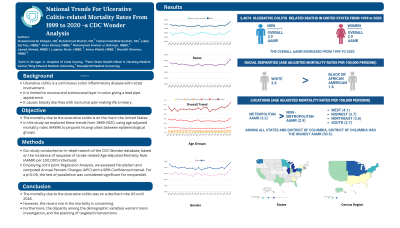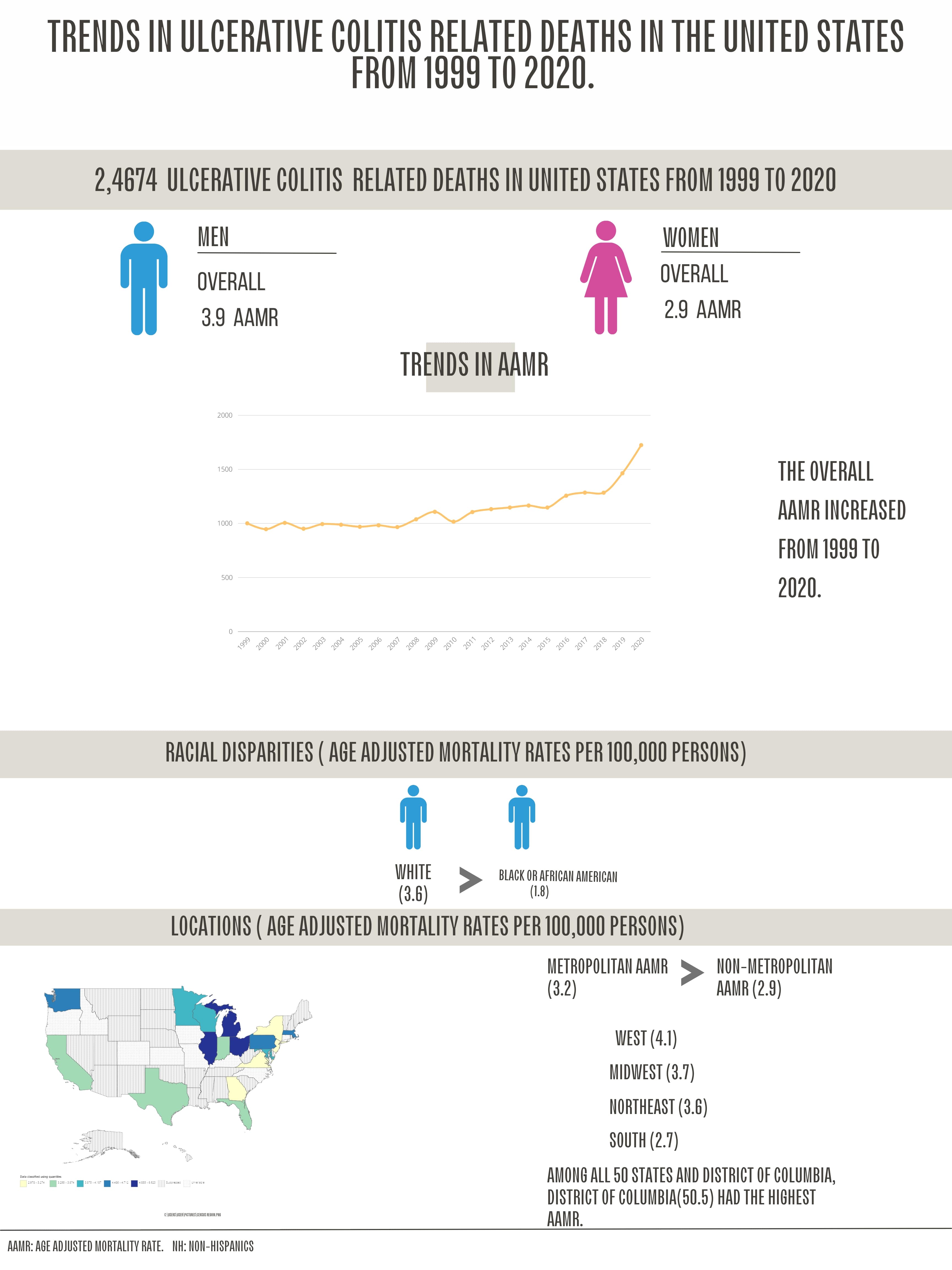Sunday Poster Session
Category: IBD
P0931 - Trends in Mortality Due to Ulcerative Colitis: Insights from a CDC WONDER Study
Sunday, October 27, 2024
3:30 PM - 7:00 PM ET
Location: Exhibit Hall E

Has Audio
- MK
Muhammad Ali Khaqan, MD
John H. Stroger, Jr. Hospital of Cook County
Lexington, KY
Presenting Author(s)
Muhammad Ali Khaqan, MD1, Muhammad Shahzil, MD2, Muhammad Bilal Ibrahim, MD1, Laiba Sarfraz, MBBS3, Iman Ahmed, MBBS3, Muhammad Ammar Ur Rahman, MBBS3, Jawad Ahmed, MBBS3, Luqman Munir, MBBS3, Amna Khalid, MBBS3, Menahil Ghuman, MBBS4
1John H. Stroger, Jr. Hospital of Cook County, Chicago, IL; 2Penn State Health Milton S. Hershey Medical Center, Hershey, PA; 3King Edward Medical University, Lahore, Punjab, Pakistan; 4Rawalpindi Medical University, Ontario, ON, Canada
Introduction: Ulcerative colitis is a chronic inflammatory disease of the colon characterized by continuous inflammation with rectal involvement. It is confined to the mucosal and submucosal layers of the colon, often resulting in a lead pipe appearance on imaging. The condition causes bloody diarrhea and nocturnal pain, significantly impacting the quality of life for those affected.
The mortality due to ulcerative colitis is on the rise in the United States. In this study we seek to explore these trends from 1999-2020, using age-adjusted mortality rates (AAMR) to pinpoint incongruities between epidemiological groups.
Methods: Our study conducted an in-depth analysis of the CDC Wonder database, focusing on the incidence of ulcerative colitis-related age-adjusted mortality rates (AAMR) per 1,000,000 individuals. Using Joinpoint Regression Analysis, we assessed parallelism and calculated annual percent changes (APC) with a 95% confidence interval. A test of parallelism with a p-value less than 0.05 was considered significant for non-parallel trends.
Results: From 1999 to 2020, a total of 24,674 deaths were reported due to ulcerative colitis. The overall age-adjusted mortality rate (AAMR) declined from 1999 to 2018, with an annual percent change (APC) of -0.35%. However, from 2018 to 2020, the AAMR began to rise significantly, with an APC of 14.50%. The highest mortality rates were observed in males and Black African Americans. Geographical hotspots for mortality included urban and western regions of the United States, with a rapid increase noted in the Northeast. Tests for parallelism revealed significant differences across gender, Black and White races (p=0.04), urban versus rural demographics (p=0.02), and South versus Midwest regions (p=0.009).
Discussion: The mortality due to ulcerative colitis was on a decline in the US until 2018. However, the recent rise in mortality is concerning. Furthermore, the disparity among the demographic variables warrants more investigation, and planning for targeted interventions.

Disclosures:
Muhammad Ali Khaqan, MD1, Muhammad Shahzil, MD2, Muhammad Bilal Ibrahim, MD1, Laiba Sarfraz, MBBS3, Iman Ahmed, MBBS3, Muhammad Ammar Ur Rahman, MBBS3, Jawad Ahmed, MBBS3, Luqman Munir, MBBS3, Amna Khalid, MBBS3, Menahil Ghuman, MBBS4. P0931 - Trends in Mortality Due to Ulcerative Colitis: Insights from a CDC WONDER Study, ACG 2024 Annual Scientific Meeting Abstracts. Philadelphia, PA: American College of Gastroenterology.
1John H. Stroger, Jr. Hospital of Cook County, Chicago, IL; 2Penn State Health Milton S. Hershey Medical Center, Hershey, PA; 3King Edward Medical University, Lahore, Punjab, Pakistan; 4Rawalpindi Medical University, Ontario, ON, Canada
Introduction: Ulcerative colitis is a chronic inflammatory disease of the colon characterized by continuous inflammation with rectal involvement. It is confined to the mucosal and submucosal layers of the colon, often resulting in a lead pipe appearance on imaging. The condition causes bloody diarrhea and nocturnal pain, significantly impacting the quality of life for those affected.
The mortality due to ulcerative colitis is on the rise in the United States. In this study we seek to explore these trends from 1999-2020, using age-adjusted mortality rates (AAMR) to pinpoint incongruities between epidemiological groups.
Methods: Our study conducted an in-depth analysis of the CDC Wonder database, focusing on the incidence of ulcerative colitis-related age-adjusted mortality rates (AAMR) per 1,000,000 individuals. Using Joinpoint Regression Analysis, we assessed parallelism and calculated annual percent changes (APC) with a 95% confidence interval. A test of parallelism with a p-value less than 0.05 was considered significant for non-parallel trends.
Results: From 1999 to 2020, a total of 24,674 deaths were reported due to ulcerative colitis. The overall age-adjusted mortality rate (AAMR) declined from 1999 to 2018, with an annual percent change (APC) of -0.35%. However, from 2018 to 2020, the AAMR began to rise significantly, with an APC of 14.50%. The highest mortality rates were observed in males and Black African Americans. Geographical hotspots for mortality included urban and western regions of the United States, with a rapid increase noted in the Northeast. Tests for parallelism revealed significant differences across gender, Black and White races (p=0.04), urban versus rural demographics (p=0.02), and South versus Midwest regions (p=0.009).
Discussion: The mortality due to ulcerative colitis was on a decline in the US until 2018. However, the recent rise in mortality is concerning. Furthermore, the disparity among the demographic variables warrants more investigation, and planning for targeted interventions.

Figure: Trends in mortality due to Ulcerative Colitis: Insights from a CDC WONDER Study
Disclosures:
Muhammad Ali Khaqan indicated no relevant financial relationships.
Muhammad Shahzil indicated no relevant financial relationships.
Muhammad Bilal Ibrahim indicated no relevant financial relationships.
Laiba Sarfraz indicated no relevant financial relationships.
Iman Ahmed indicated no relevant financial relationships.
Muhammad Ammar Ur Rahman indicated no relevant financial relationships.
Jawad Ahmed indicated no relevant financial relationships.
Luqman Munir indicated no relevant financial relationships.
Amna Khalid indicated no relevant financial relationships.
Menahil Ghuman indicated no relevant financial relationships.
Muhammad Ali Khaqan, MD1, Muhammad Shahzil, MD2, Muhammad Bilal Ibrahim, MD1, Laiba Sarfraz, MBBS3, Iman Ahmed, MBBS3, Muhammad Ammar Ur Rahman, MBBS3, Jawad Ahmed, MBBS3, Luqman Munir, MBBS3, Amna Khalid, MBBS3, Menahil Ghuman, MBBS4. P0931 - Trends in Mortality Due to Ulcerative Colitis: Insights from a CDC WONDER Study, ACG 2024 Annual Scientific Meeting Abstracts. Philadelphia, PA: American College of Gastroenterology.
